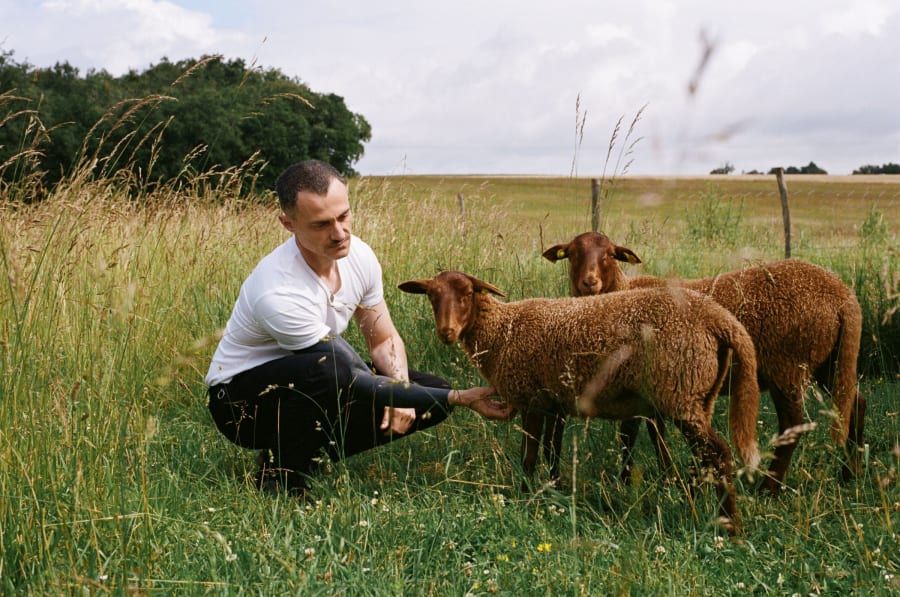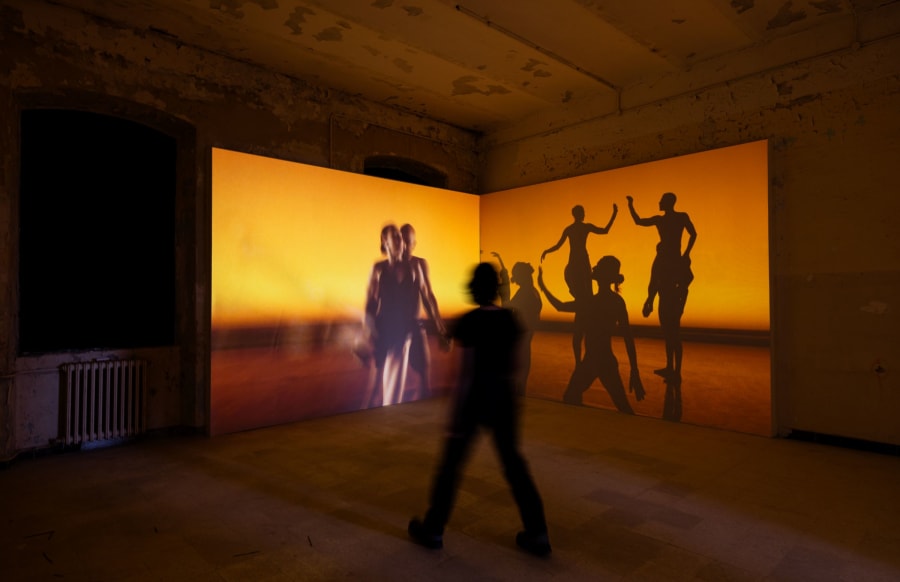From Lake Geneva and Lake Maggiore to Lake Lucerne, Switzerland’s picturesque lakes are as much a part of the country’s DNA as its world-famous mountains. A number of artists have found intriguing motifs in them, most prominent among them Ferdinand Hodler (1853-1918), who sketched and painted them relentlessly. To Hodler, landscapes were almost sentient, full-fleshed individual characters. Similarly, various contemporary artists have set out to capture the essence of Swiss lakes, all in their own unique way.
在這位德國藝術家於紐約貝浩登(Perrotin)舉辦的首次個展「When the Sun Hits the Moon」中,有幾幅畫作是初次亮相,主題為安東尼奧.卡諾瓦(Antonio Canova)的新古典主義雕塑中描繪的愛神厄洛斯與普姬幾乎接吻的場景。愛神不允許他的世間愛人看到他在光明中的樣子;當普姬拿著蠟燭對著愛神面龐的那一刻,這對戀人就永久地斷開了聯繫。Greven說:「我喜歡這個意象,因為我捕捉到的那一刻,他們還在互相對視,但未真正看見對方的面貌。他們仍處於黑暗之中,以內心注視和以內在擁抱。」
For the painter Thomas Huber (b. 1955), the lake becomes a place to return home to. ‘Lago Maggiore’, the title of his recent solo show at MASI Lugano, signaled a shift in Huber’s oeuvre. The largest paintings on view did away with the architectural elements that define Huber’s earlier works. One painting, titled Am Abend (2023) and executed in a panoramic 3-meter-wide format, offered an almost immersive experience of the lake in the evening glow. Shown from a vantage point above, the body of water is framed by heavily stylized sloping hills and round shapes indicating trees. The silhouettes of buildings and twinkling lights on the lakeshore suggest a contemporariness, while the motif of the lake vista is executed with a sleek perfection manifesting timelessness. Returning to the Swiss-Italian border region after spending decades in Berlin, Huber’s devotion to and close observance of the local landscape taps into a universal need to feel anchored and at home somewhere.
Leiko Ikemura (b. 1951) has been heralded for infusing European painting traditions with Japanese philosophy. The multidisciplinary artist, who grew up in Japan and spent time in Spain, Switzerland, and Germany, has said that Swiss landscapes ‘such as the mountains and the lakes’ are deeply ingrained in her mind. The medium-sized panel Mountain Lake (2010/2011) shows a landscape on the verge of dissolving into abstraction. The lake has all but disappeared, with only a thin blue line connoting its edge. In the hands of Ikemura, the landscape becomes a portal that allows viewers to find commonality with nature. Ikemura has stated that she believes lakes to be universal landscapes, ‘a kind of prototype.’ In its own way, this stance may be the most direct continuation of Ferdinand Hodler’s legacy, and his search for the ‘essential.’
Jean-Frédéric Schnyder’s (b. 1945) approach to painting lakes is decidedly more pragmatic. Schnyder has demonstrated an insatiable appetite for new motifs and painting styles, depicting everything from clowns, highways, and overpasses to the family’s Tibetan Terrier Dritchi and mountain summits marked with glowing pink crosses. In 1996, he captured the sunset on Lake Zug in central Switzerland 163 times, riding a bike the short distance from his home to find a suitable view, and using what little time was left before the sun disappeared behind the horizon to finish his small-scale paintings en plein-air. All works in the series show the same basic arrangement; any discernible variation is due to light and weather conditions – or the occasional appearance of a swan. Schnyder is not seeking mythical transfiguration. His technique is often flat and intentionally naive, amateurish, badly painted or approximate. It is as if the painter is saying: ‘I’m not trying to make it beautiful, and I can’t help it if you see it that way.’ Schnyder applies the same logic to all the motifs he depicts, embracing a non-hierarchical logic that forces the viewer to consider his works with a quintessentially Swiss sort of cool distance.
Lake Geneva is a source of constant inspiration for Caroline Bachmann (b. 1963), who lives and works in Cully, a charming medieval village on its shores. Her practice of repeatedly painting the view from her home has taken on the sort of mythic quality associated with great artistic figures. The daily ritual, which is said to take place at night or in the early morning hours, consists of Bachmann sitting down to sketch the lake as it appears in that particular moment, noting the lighting and weather conditions, and adding details such as clouds, waves, or whatever else strikes her fancy. In Risée croissant de lune (2021), the act of contemplation manifests itself as a barely visible sliver of a rising new moon while the remnants of daylight disappear behind a darkened mountain range. To Bachmann, the lake is a source of restoration, a container for vibrations, a theater of matter, and offers inspiration on a silver platter. She treats each element as if it were a character in a scene.
Last but not least, Roman Signer (b. 1938), decidedly not a painter, has found an ingenious way to add his own version of a lake vista to his oeuvre, with the site-specific and permanent installation Seesicht (2015). Placed prominently on the lakeside promenade in Zug, the steel sculpture consists of a staircase leading well below the water level and offering an unfamiliar view of the lake through a large window. Depending on the time of day, one might see fish swimming close by, or rays of sunlight penetrating the water surface above. This artistic natural observatory is in keeping with the artist’s core interest in physical elements in motion. To Signer, the lake is less something to be looked at, but rather a force of nature to be experienced.
It is curious to think about how the lakes of Switzerland have triggered different artistic responses. Seen through the eyes of these artists, the lake might be a magical subject, a sentient counterpart, a portal, a stylistic device, or a source of restoration. If you have ever spent a day at a lake, observing the changing light and weather, you might have your own notion to add, and let me be the first to tell you that you, too, are right.
Andriu Desplazes is represented by Galerie Peter Kilchmann (Zurich and Paris). Thomas Huber is represented by Skopia / P.-H. Jaccaud (Geneva). Leiko Ikemura is represented by Galerie Karsten Greve (Cologne, St. Moritz, Paris) and Lisson Gallery (London, Los Angeles, New York, Shanghai). Jean-Frédéric Schnyder is represented by Galerie Eva Presenhuber (Zurich, Seoul, Vienna). Caroline Bachmann is represented by Galerie Gregor Staiger (Zurich, Milan) and Meyer Riegger (Berlin, Basel, Karlsruhe, Seoul). Roman Signer is represented by Art : Concept (Paris), Galerie Martin Janda (Vienna), and Hauser & Wirth (Zurich, Hong Kong, London, Los Angeles, New York, Paris, Somerset, St. Moritz).
Rebecka Domig is an art historian, writer, and curator at Kornhausforum, Bern.
Caption for top image: Jean-Frédéric Schnyder, 411 Der Niesen am 21. Dezember (detail), 1987. Collection Ringier. Courtesy of the artist and Galerie Eva Presenhuber. © The artist.
Published on July 30, 2024.


